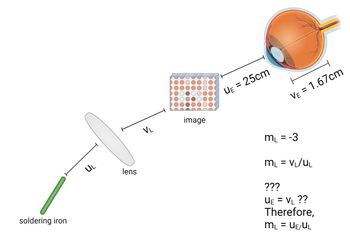When you solder electronic components, you want to keep your face away from the work but still be able to see it clearly, so you use a soldering stationwith a built-in lens. Clips hold the work you are soldering, and a flexible arm holds the lens above the work. You view the work from some distance, but the area under the lens is magnified enough that you can see fine details. A typical magnifier is rated at 3×. How far from the work should the lens be placed?
Ray Optics
Optics is the study of light in the field of physics. It refers to the study and properties of light. Optical phenomena can be classified into three categories: ray optics, wave optics, and quantum optics. Geometrical optics, also known as ray optics, is an optics model that explains light propagation using rays. In an optical device, a ray is a direction along which light energy is transmitted from one point to another. Geometric optics assumes that waves (rays) move in straight lines before they reach a surface. When a ray collides with a surface, it can bounce back (reflect) or bend (refract), but it continues in a straight line. The laws of reflection and refraction are the fundamental laws of geometrical optics. Light is an electromagnetic wave with a wavelength that falls within the visible spectrum.
Converging Lens
Converging lens, also known as a convex lens, is thinner at the upper and lower edges and thicker at the center. The edges are curved outwards. This lens can converge a beam of parallel rays of light that is coming from outside and focus it on a point on the other side of the lens.
Plano-Convex Lens
To understand the topic well we will first break down the name of the topic, ‘Plano Convex lens’ into three separate words and look at them individually.
Lateral Magnification
In very simple terms, the same object can be viewed in enlarged versions of itself, which we call magnification. To rephrase, magnification is the ability to enlarge the image of an object without physically altering its dimensions and structure. This process is mainly done to get an even more detailed view of the object by scaling up the image. A lot of daily life examples for this can be the use of magnifying glasses, projectors, and microscopes in laboratories. This plays a vital role in the fields of research and development and to some extent even our daily lives; our daily activity of magnifying images and texts on our mobile screen for a better look is nothing other than magnification.
When you solder electronic components, you want to keep your face away from the work but still be able to see it clearly, so you use a soldering station
with a built-in lens. Clips hold the work you are soldering, and a flexible arm holds the lens above the work. You view the work from some distance, but the area under the lens is magnified enough that you can see fine details. A typical magnifier is rated at 3×. How far from the work should the lens be placed?
Trending now
This is a popular solution!
Step by step
Solved in 3 steps with 3 images

Can you please explain how...well...how this works. Can you draw a diagram or something?
It seems like if you use m=v/u and enter 25 cm for v, then you're saying that the image is 25cm from whatever the rest of the system is in the equation. m is the magnification of the lens, so when you arrive at the value for u, that seems like it should be saying that if you put the iron 8.3 cm from the lens, then it will project the image 25 cm from the lens. Not 25 cm in front of your eyes. I don't understand how the answer ends up applying to the distance to the eyes. Is there some algebra that needs to be done to link the distance from the image to the distance to the eyes?
By the way, what do v and u stand for? I know they're distances, but what words do the letters represent?









